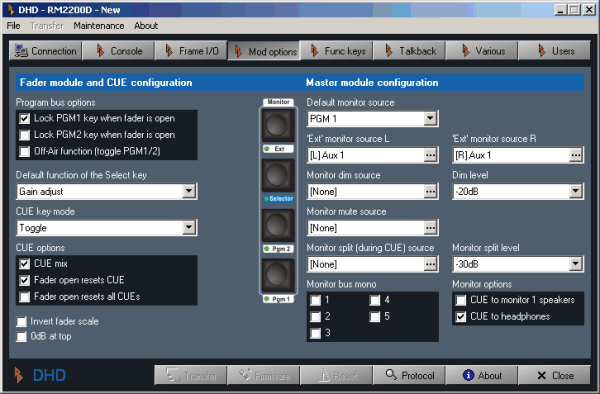Use this configuration dialog to adjust the way the modules on the mixing desk work.
These options affect the function of all fader modules in the mixing desk.
Lock PGM 1 key when fader is open. If you check this checkbox, you can not remove a fader channel routing from the “PGM 1” bus using the PGM 1 key, as long as the fader channel is open. You should activate this option if PGM 1 is the On Air summing bus.
Lock PGM 2 key when fader is open. If you check this checkbox, you can not remove a fader channel routing from the “PGM 2” bus using the PGM 2 key, as long as the fader channel is open.
Off Air function (toggle PGM 1/2). If you check this checkbox, the two routing keys PGM 1 and PGM 2 are toggling each other. If you press one of them, the other gets released. This is useful for Off Air recording purposes. (see also Off Air Operation)
Default function of the Select key. Use this pop up menu to select which function is active when the Select key is pressed in a fader channel. You can choose between Gain adjust and Input selection.
CUE key mode. Use this option to configure the behaviour of the CUE keys. These options are available:
Toggle. The key latches when pressed. It stays on until pressed again.
Timed Toggle. The key latches when pressed shortly, it releases when pressed again. When pressed longer, it stays on until it is released again.
Momentary. The key stays on until it is released again.
CUE mix. If you check this checkbox, you can cue several channels at the same time. All CUE/PFL signals are mixed on the CUE bus. If you uncheck this option, only one fader channel at the time can be cued. If you press another CUE key, it will release the currently active one.
Fader open resets CUE. If you check this checkbox, opening a fader will release the CUE key of the same fader only.
Fader open resets all CUEs. If you check this checkbox, opening any fader will release all currently active CUE keys.
In this part of the dialog you can configure general settings for monitoring and CUE functions.
Default monitor source L. Use this option to select the default signal for monitoring (left channel). This signal is routed to the monitor after the RM2200D is reset and also in case no other monitor source is active. When you press any of the four monitor keys on the Master Control Module, you select its input and the associated key LED lights up. When you press it again, the key LED goes off and the default monitor signal comes back. Use the button to bring up the Audio Sources window to select any other audio signal.
Default monitor source R.Use this option to select the default signal for monitoring (right channel). Use the button to bring up the Audio Sources window to select any other audio signal.
‘Ext‘ monitor source L. Use this option to assign any available signal (left channel) on the audio bus to the Ext monitor key in the mixing desk. If you press this key, this signal is routed to the monitor. Use the button to bring up the Audio Sources window to select any other audio signal.
‘Ext‘ monitor source R. Use this option to assign any available signal (right channel) on the audio bus to the Ext monitor key in the mixing desk. If you press this key, this signal is routed to the monitor. Use the button to bring up the Audio Sources window to select any other audio signal.
Monitor dim source. Use this option to select which logic source is used to dim the monitor signal. You could use this, for example, to control the monitor dimming via a GPI from an external intercom system.
Dim level. Use this pop up menu so select the attenuation for dimming the monitor. You can choose levels between 0 dB and -30 dB.
Monitor mute source. Use this option to select which logic source is used to mute the monitor signal.
CUE to monitor. If you check this checkbox, the CUE / PFL bus is routed to the monitor 1 loudspeakers when at least one CUE button is active.
CUE to headphones. If you check this checkbox, the CUE / PFL bus is routed to the monitor 1 headphones when at least one CUE button is active.
